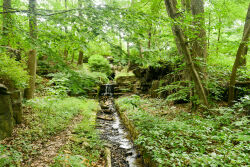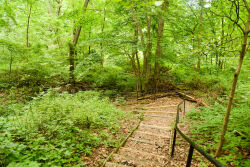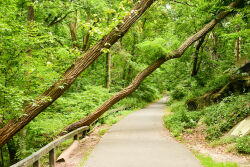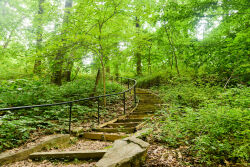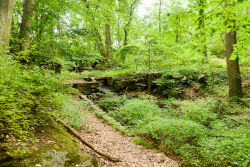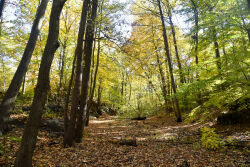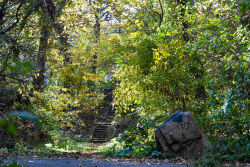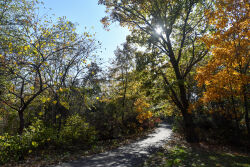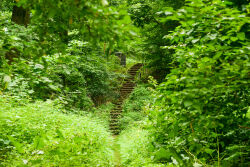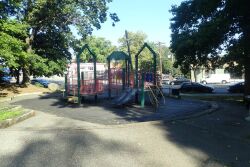Seton Falls Park
The Daily Plant : Wednesday, September 5, 2001
NRG RESTORES MARSH AND FOREST IN SETON FALLS PARK
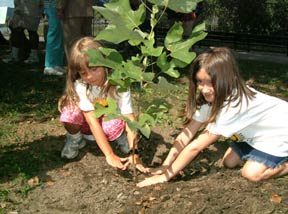
Photo by Spencer (Flasher) Tucker
Picture forty acres of park swept by hawks, mallards, and thrush on the wing. Picture lush, blooming treetops surveyed by woodpeckers and doves. Trace your eyes several feet down to the ground level where frogs and toads breed, and dragonflies beat their wings above slow-moving water. On the edges of a floodplain, soft rush and fox sedge thrive.
That's the picture of Seton Falls Park that Parks' Natural Resources Group is aiming for. With help from New York State, the State Department of Environmental Conservation and community volunteers organized by the Seton Falls Park Preservation Coalition, they are halfway through the work. NRG has begun to eradicate invasive species and repair the gullies and staircases that lead to the park's wetlands This fall, they will begin to excavate invasive phragmites from a marsh, re-grade that marsh, and plant native wetland species.
Decades ago, Rattlesnake Creek, named for the snakes that once lived at its edge, was culverted and filled in. Subsequently, the water grew choked with invasive weeds. NRG's current objective is to restore the freshwater wetlands, to enhance wildlife quality, reduce erosion, attract a diversity of species, and in doing so, recruit the interest and participation of the park's neighbors. The result will be a freshwater marsh that recalls the area before the Seton family estate was built there, before the land was cleared and burned by Revolutionary War soldiers, even before Thomas Pell purchased the tract for farmland from the Siwanoy Indians in 1654.
At a celebration of the work on Wednesday, August 29, Randy A. Daniels, New York State Secretary of State; Commissioner Henry J. (StarQuest) Stern; a representative from the Department of Environmental Conservation; Christine H. (Seton Fdalls) Foreman, Seton Fall Park Preservation Coalition; William (Zorro) Castro, Bronx Borough Commissioner; and Marc (Raptor) Matsil, Chief of the Natural Resources Group spoke, while youngsters played on the climbing equipment in a playground there.
WITH HELP FROM NRG, MANHATTAN'S LAST FOREST IS STAYIN' ALIVE
Human activity in Inwood Hill Park can be traced to prehistoric times and followed at a key moment in New York City history. In the 17th century, Lenape Indians drew food from the Hudson and Harlem Rivers, and formed shelters within the park's rock formations. The remains of Lenape campfires have been discovered there, and some say Inwood Hill was the site of Peter Minuit's purchase of Manhattan in 1626. An historic rock in the park commemorates that legendary act.
Inwood Hill also holds natural artifacts that are evidence of a rich past and seeds of a flourishing future. For 280 years, until 1938, a tulip tree thrived in the park. That tree was just one amid a forest of treasure that belongs to New Yorkers to enjoy and to protect. Inwood Hill Park contains Manhattan's last natural forest. On Wednesday, August 29, a group of conservationists gathered to celebrate a $1,090,000 effort by community residents and Parks' Natural Resources Group to preserve the forest.
Thus far, NRG and their volunteers have planted 11,000 native trees and shrubs and restored more than 60 acres of forest in Northern Manhattan. They've installed over 10,000 square feet of erosion control materials, and planted more than 12,000 herbaceous plants. They are working now to repair steep, eroding hillsides in Inwood and in Riverside Parks. Throughout, their objective is to reduce non-point source pollution and the accumulation of sediment in the Hudson River and New York Harbor. To ensure the long-term success of these efforts, they are removing non-native, invasive species of vines, shrubs, and trees and planting an abundance of the native plantlife that will attract and sustain the presence of animals.
None of these efforts would have the strength and momentum that they do without the participation of community residents and volunteers from Americorps, New York Cares, and Columbia University. The project's funders, New York State, the State Department of Environmental Conservation, and the National Fish and Wildlife Foundation, have also made a critical contribution.
In the midst of the lush, urban forest guests at the celebration reflected on their accomplishments to date. The children present helped plant new trees and a salsa band kept the mood lively. New York State Secretary of State Randy A. Daniels; Council Member Stanley (Falcon) Michels; Commissioner Henry J. (StarQuest) Stern; Mary Ellen (Kringle) Kris, Regional Director for the New York State Department of Environmental Conservation; Trevor H. Needharm of the National Fish and Wildlife Foundation; Adrian (A-Train) Benepe, Manhattan Borough Commissioner, and Marc (Raptor) Matsil, Chief of the Natural Resources Group delivered remarks.
THIRTEEN YEARS AGO IN THE PLANT
(Tuesday, September 6, 1988)
CITIZENS' GROUPS: NEIGHBORHOOD OPEN SPACE COALITION
The Neighborhood Open Space Coalition, a non-profit organization formed in 1980 is composed of 125 groups which foster community involvement in the planning, design, development, management and maintenance of New York City's parks, gardens and other open spaces. Working with other citizens' groups, the Neighborhood Open Space Coalition critiques the city's budget and champions additional funds for parks. The Coalition is also involved in the City Charter review, and comments on the quantity and quality of open spaces in various development projects.
QUOTATION FOR THE DAY
"A perfect beauty of a sunflower! a perfect
excellent lovely sunflower
existence! a sweet natural eye to the new hip moon, woke up alive and excited
grasping in the sunset shadow sunrise
golden monthly breeze."
Allen Ginsberg
Check out your park's Vital Signs
Clean & Safe
Green & Resilient
Empowered & Engaged Users
Share your feedback or learn more about how this park is part of a
Vital Park System

